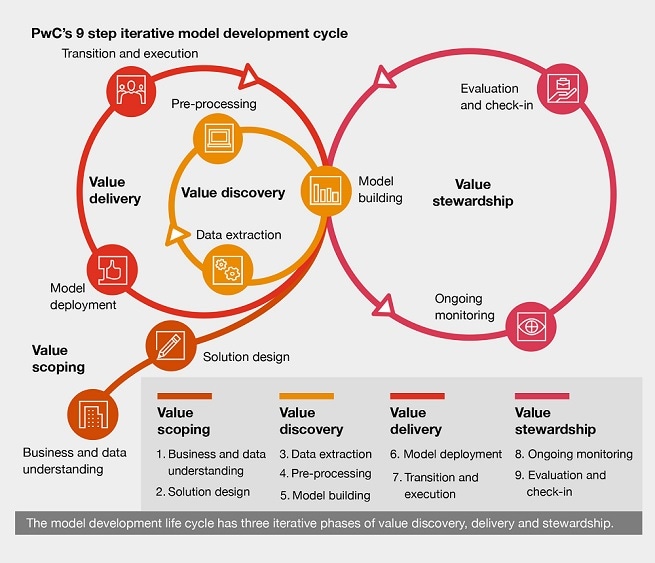The way forward
Investment and buy in
One in four enterprises finds it difficult to secure enough investment and buy-in from its leadership.
- Make AI projects accessible in as many departments as possible, focusing on shared ownership.
- Start small and with pilot-focused scoping to quickly show the value and get buy-in.
Right use cases
37% of organisations find it challenging to identify the right use cases for AI implementation.
- Based on the leadership buy-in and organisational goals, start early identification of the realistic, achievable and quick-win use cases from the wider range of analytics automation and digital driven needs.
- PwC’s use case criticality evaluation criteria help drive use cases across six different factors.
Use case criticality components
Revenue
The total of the economic impact of a single prediction, the economic utility of understanding why a single prediction was made, and the intelligence derived from a global understanding of the process being modelled.
Rate
The number of decisions that an AI application has to make e.g. two billion per day versus three per month.
Regulation
The regulations determining the acceptable use and level of functional validation needed for a given AI application.
Reputation
How the AI application interacts with the business, stakeholders, and society and the extent a given use case could impact business reputation.
Risk
The potential harm due to an adverse outcome resulting from the use of the algorithm that goes beyond the immediate consequences and includes the organisational environment: executive, operational, technology, societal (including customers), ethical and workforce.
Quality datasets
28% of enterprises lack high-quality data for use in AI solutions.
- Identify the data sets that you need in order to train AI to solve specific business problems, then prioritise capturing and labelling that data in line with enterprise-wide standards.
- Use synthetic data generation and new AI data tools like lean and augmented data learning, transfer learning and other AI approaches that can help do more with less, much more easily.
Training and recruitment
28% of firms report training and recruiting skilled professionals who can work with AI systems as a hurdle.
- Plan opportunities and recognition for upskilling and retraining.
- Develop a citizen-led culture to provide employees the tools, platforms and incentives to learn and apply skills, and back it up through compensation and recognition.
- Create a multilingual environment where data engineers, data ethicists, data scientists, and machine learning (ML) Ops engineers can collaborate with each other.
Pilot to production
35% of organisations that have implemented pilots are finding it tough to move AI initiatives from pilot to production.
- Ensure availability of high-quality and unbiased datasets and use cases that align with organisational goals and values. Cognitive assets, company-wide capabilities, a formalised, time-bound approach and robust infrastructure can help deploy AI solutions from pilot to production.
- Use an experiment-driven model life cycle to break down and construct AI projects through iterative feedback loops and value-aligned building blocks. PwC’s model life cycle with feedback loops helps establish the iterative processes needed to succeed in building and deploying AI.

Explainability of AI decisions
38% of organisations are unable to explain the output and measure AI’s RoI.
- Ensure that AI deployment efforts address five key questions to solve the challenges of explainability – (i) whom to explain to? (ii) why explain? (iii) when to explain? (iv) how to explain? (v) what is the explanation?
- Simulation techniques and digital twins will allow you to consider thousands of potential outcomes and then select the best strategic bets, option-value bets and no-regret strategies that are robust, thus minimising any negative impact on investment and efforts.
- For the RoI to be realistic, it is important that you are able to trust the decisions made by AI. PwC’s Responsible AI – a suite of customisable frameworks, tools and processes – can help explain both overall decision making, as well as individual choices and predictions made by AI systems.
Governance of AI
One in five organisations finds it challenging to create AI-related governance policies across the business.
- Given the ubiquity and pervasive nature of technology in business, prioritise management of risks and controls at every step of the AI journey – from strategy and planning to monitoring of deployed solutions.
- Consider existing AI deployment capabilities and the vendor ecosystem, along with the unique model development, model monitoring and compliance processes
- Instil confidence on the customer and compliance front, install capabilities for expanded business reporting.
Maintenance of AI
17% of firms face challenges in maintaining AI systems that are already operational.
- Build oversight mechanisms to monitor how AI models perform over time and develop robust maintenance procedures to update the models before business is affected by value decay, hidden costs and other unforeseen changes in the environment (e.g. cascading technical debt, falling adoption due to lack of transparency or bias creep).
Scaling up AI
20% of organisations find it challenging to scale up AI solutions at the enterprise level.
- Embed AI into your overall IT stack to scale up its use and support a common AI services layer that allows multiple applications to integrate with AI models.
- Develop ML operations combining expertise in data science, software engineering and IT operations.
- Make your data ‘trustworthy’, i.e. not only accurate but also standardised, labelled, complete, free of bias, compliant with regulations and secure to scale.
Delivering innovation
38% of organisations plan to use AI to deliver rapid innovation in a post COVID-19 world.
In a rapidly changing post COVID-19 world, it is more important than ever to rethink and reconfigure to become dynamic and resilient to future disruptions. As organisations try to drive market-leading innovations through the use of AI, it is important to build capabilities to:
- continually sense market variables, assess the range of scenarios and most favourable outcomes
- gather feedback on experiments by reinforcing causal feedback loops
- build and improve capabilities to address the feedback













